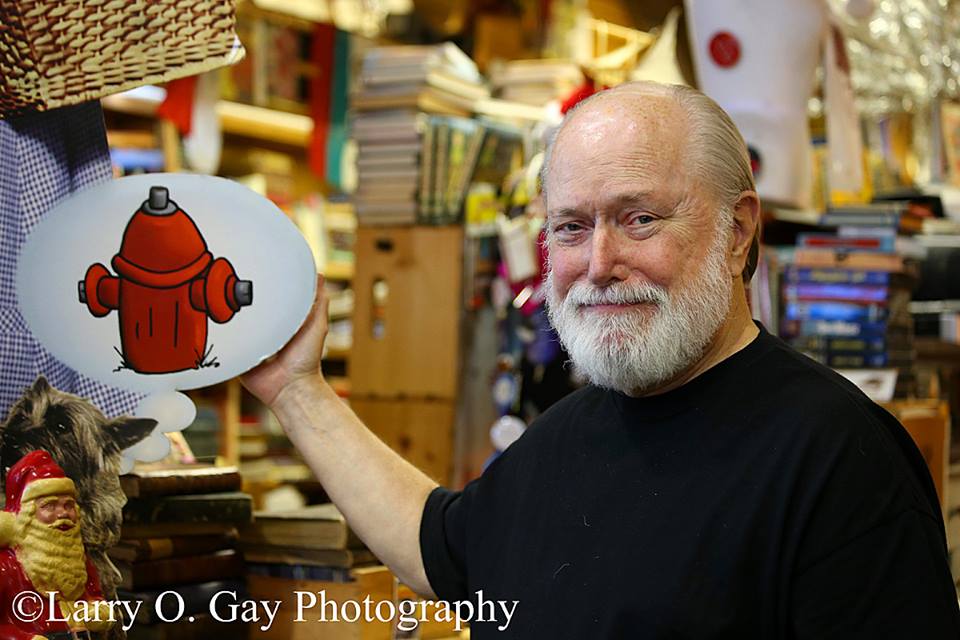Listen to Jim’s podcast:
http://redclaydiary.com/mp3/
or read his story below:
HERE INFINITY AND ETERNITY RESIDE
One enthusiastic customer, beaming, walks up to the front of the store balancing a waist-to-chin stack of books he wants to purchase.
As I begin to add up his finds, I notice that they are all about astronomy, the scientific heavens, real space travel, cosmic phenomena, stargazing, telescope making…
This takes me back to a time some sixty years ago when I was an amateur astronomer reading and poring over some of these same titles.
I wax nostalgic about my childhood planetarium, star maps, late-night watches, eclipse predictions…
“You know there’s going to be a major solar eclipse this year!” he reports. He plans to travel to the Carolinas with family to view an event most people won’t even know is happening.
OK. This makes me want to tell the story of my blacktop fireflies.
Stop me if you’ve already heard this. Here goes…
BLACKTOP FIREFLIES
The firefly nights and the ‘skeeter mornings frame each day as we the children of summer and autumn play at our chores and work hard at our play.
Back then, in childhood (where I suddenly am transported), time doesn’t matter at all. We are too young to notice time slipping and sliding past our nighttime openscreened windows.
Sometimes we lie on our backs on the black flat roof of our small home at 26 Eastwood Avenue in Tuscaloosa, Alabama, and gaze up at the stars and the planets and the Moon and an occasional meteor and an even less frequent comet, and we lie there and breathe the dampened chilly nonpolluted air, sometimes unable to tell the difference between shooting stars and spasmed fireflies.
The shooting stars can be oohhed and ahhed at, but we can never catch one unless we are lucky enough to be hit directly, and then wouldn’t we be famous for a while? “There goes that boy who got hit by that meteor,” everyone would say.
The fireflies we touch and gently cradle in our palms and place in widemouthed Ball jars for a few minutes in hopes of getting enough together to light the entire neighborhood, but we never gather quite that many, because there is always something else to do.
Lying here on the flat black roof, looking at the stars and smelling the moist fragrance of the old quilts Mother lets us use, we do not notice the mosquitoes. There is just too much to do, you see. We have to count the stars and figure out how many per square foot are up there, we have to hide the Moon behind our thumbs, we often count the number of meteors we see in a 15-minute period, then chart their paths on a sky map, we need to take the lens cap off the old Criterion cardboard-tube refractor telescope and take a close look at the stars and now and then at the neighbors’ homes, we have to wonder which of those tiny colored lights moving very high up in the sky might be satellites or planes or unidentified flying objects.
We never get bored, because we do not yet know what time is. We do not know that time passes and that everything changes all the time–even us, even our dreams.
We only know that lying on our backs on the flat blacktopped roof, munching on a few Graham crackers we have taken from the kitchen, is the only thing going on that we are aware of.
The stars twinkle. The planets do not. The Moon is so glowy bright. The crickets provide ambience so cleverly and persistently that we seldom hear them.
The fact that the flat black roof is stone hard is not even noticed. We sleep like the near-babies we still are.
At long last, the Sun begins to rise and we slowly wake up to its radiant pressure on our faces and feel the dew over our clothes and now-soggy Graham crackers and quilts, and we never guess that the Sun might never rise again, we never think about the stars disappearing, we only wonder how far the Sun and stars go and what lies beyond the boundaries of the Universe. One thing we do know: we are dead-center in the middle of the Universe. We are each the center of the Universe. And we somehow know, instinctively know, that every creature in the Universe, whether on Earth or on Jupiter or in a distant galaxy, every creature, wherever it is, is definitely and individually at the center of the Universe, too. We somehow know that the center of the Universe is always wherever we are at the moment, no matter who or what we are.
So, 26 Eastwood Avenue is the center of the Universe and at least in one dusty wing of my heart, it will always be thus
© Jim Reed 2017 A.D.
http://www.jimreedbooks.com/podcast
